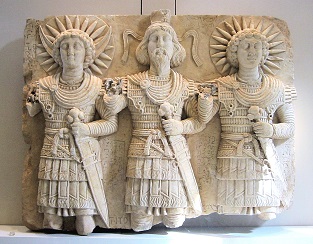|
Vahagn

Aliases: Vahagan, Vahakn, Verethragna (Victory), Dsovean
Location: Armenia
City: Aštišat
Estimated Date: 500s B.C. - 400s A.D.
He is associated with Ba'al Hadad, Apollo and Mithras and wears the same cap as Attis, Mithras and a god similar to Dionysus

Syrian triad of gods: Aglibôl, Beelshamin, and Malakbel
Vahagn is an Armenian storm god of fire and war like Ba'al Hadad, who carried a lyre like Apollo, and is depicted wearing the same Phrygian cap seen depicted on Attis, Mithras and the Dionysian opponent of Apollo, Marsyas. He was identified with Hercules by Armenian writers and was the son of Aramzd, better known as Ahura Mazda, the Zoroastrian chief god, and the brother of Anahit, or Anat, Ba’al Hadad’s sister. Thus the Armenians had a triad of Aramzd, Vahagn and Anahit, which was equivalent to another triad from the neighboring Urarteans: 1) Haldi, a warrior god; 2) Theispas, a storm god equated with Ba’al Hadad and Teshub, the Hittite Zeus; 3) and his sister Artemis, who was equated with Anat. The fifth century Christian prince Artaxias IV (Artashes), who served as a Sassanid client king to a Zoroastrian Armenia, likewise cited three gods: Aramazd (Ahura Mazda), Mihr (Mithras), and Anahit (Anat). There was also a triad of gods in the first century A.D. city of Palmyra in Syria: 1) the supreme god, Beelshamen, or Ba'al-Shamin, “Lord of the Heavens”; 2) the lunar god, Aglibôl, “Calf of the Lord”, who, although male, is linked to the Syrian Venus, Astarte; and 3) the sun god, Malakbel, or “Messenger of the Lord”.
He defeats a dragon, just like Yahweh and the archangel Michael
He is best known for being the “Dragon Reaper”, similar to dragon slaying qualities of Yahweh, the archangel Michael in Revelation, as well as Ba’al Hadad and Apollo.

His lover is associated with Venus and is named after the Easter goddess
Vahagn’s wife or lover was Astghik, or Ast-ghig, literally “East Star,” that is, Venus, equivalent to Eostre, or Easter, through the proto-Germanic austron, or “dawn”, which like Astghik is derived from the Proto-Indo-European dawn goddess haesous. The word is likewise the root of the Gallic hearth god Esus, who is portrayed cutting down branches from a tree and was invoked by charms for healing. The eighth century monk Bede confirms that Eostre was an Anglo-Saxon goddess whose feast was celebrated on or near the Spring Equinox. She was identified with Aphrodite by Hellenizing Armenians, who like the Persians and other sun worshippers from the East prayed towards the rising sun, which was adapted by the Armenian Christian Church so that even today bodies are always buried facing the rising sun with the back towards the fallen angel. Although many people have scoffed at a popular internet meme that says the word Easter was etymologically related to the Akkadian goddess Ishtar because of the distance between Norway and Babylon, but the fact is that Ishtar was worshipped by the Hittites and Syro-Hittites west of Armenia, so if there is no relationship, it means that through a complete coincidence, two fertility goddess with very similar names, both associated with the “east star” Venus and both connected to a dying-and-rising god ended up crisscrossing one another and became identified with one another by their respective cultures.

Esus, the Gallic god of the hearth
Next God: Krishna
The Dying-and-Rising Gods
Leave Comments Here
|

